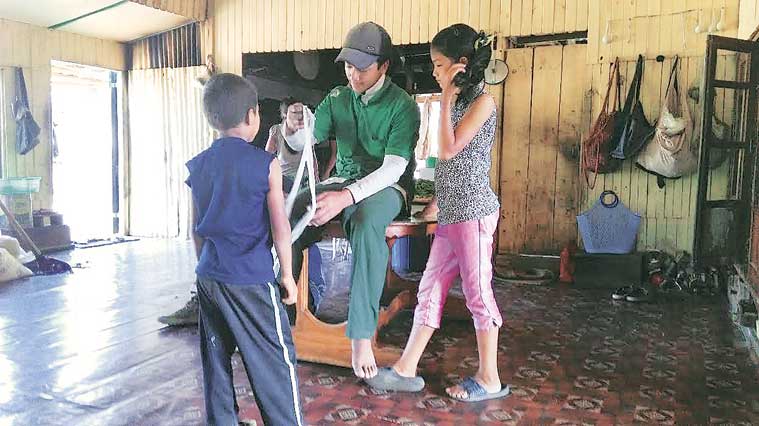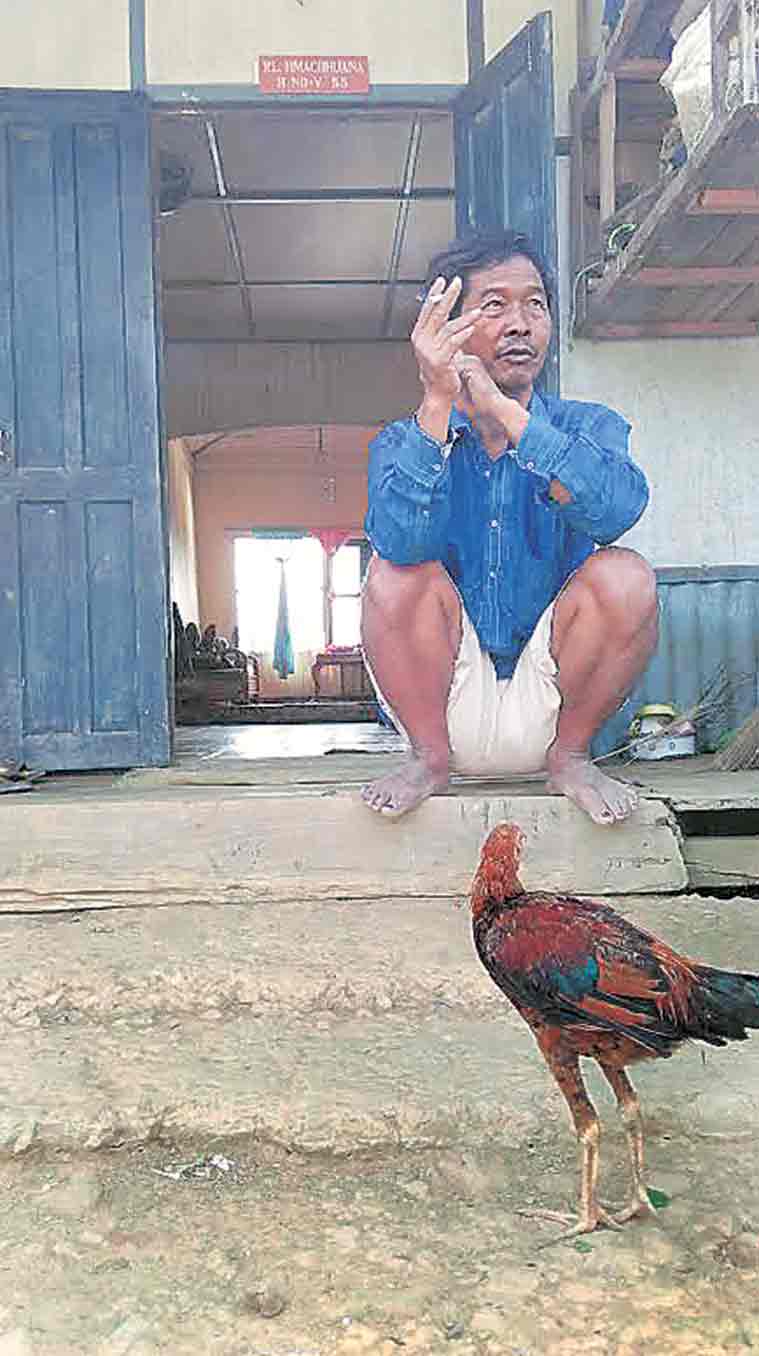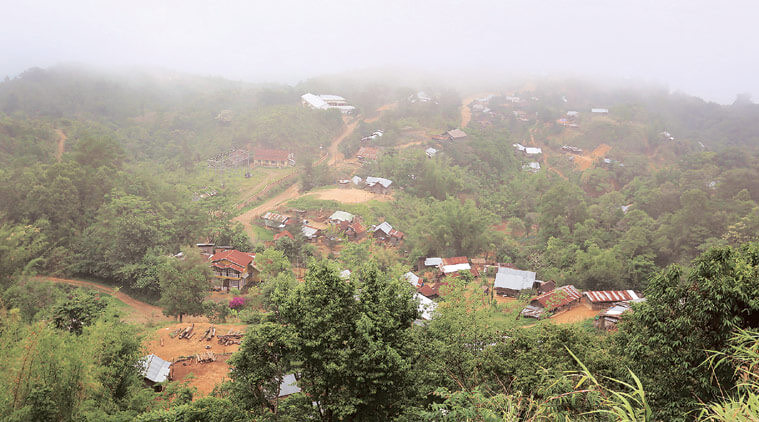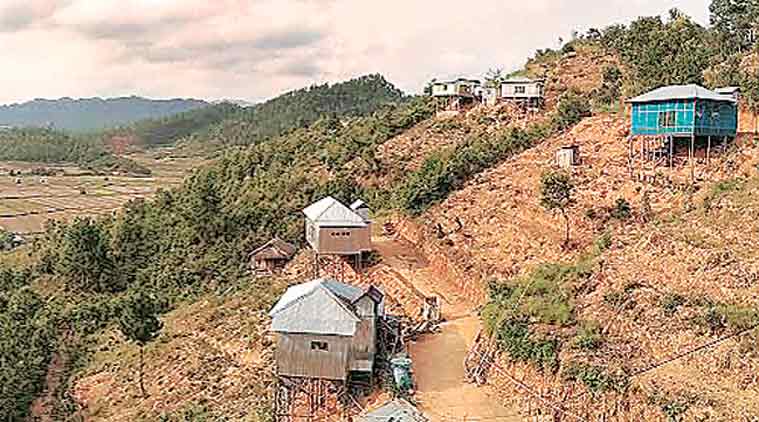The
Mizos of Tamu went out of their way, the group says, to ensure they
were not jailed and a formal case was not registered. It helped that the
elected representative of Tamu was, till his recent demise, a Mizo. The
local Mizos also bargained with the authorities to be allowed to feed
the detained group
By the late 1980s, Tlangsam, a village of around 400 families, had come
to be known as the home of the religious sect ‘God’s Church’ that
feared a giant rock would roll down from the east and cause great
destruction (Source: Express photo by Adam Halliday)
UID number was that of the anti-Christ, they thought, and a war
and an unexplained darkness were coming. 19 people from Mizoram set off
on a 200-km trek across mountains to Myanmar, fuelled by this faith
rather than reason — and found love at the end. ADAM HALLIDAY retraces
the journey. Photographs by ADAM HALLIDAY
The district
A 3,185 sq km district with a population of around 1 lakh, Champhai has a
special place in Mizoram. It is said the history of Mizos starts from
Champhai and ends in Champhai. The town is also a fast developing venue
on the Indo-Myanmar border. The World Bank is currently financing the
building of a four-lane highway between the border village and Champhai
town.
A problem
A UIDAI drive is currently on in Champhai district. The 19 — members of
one extended family — belong to Tlangsam village of the district. An
official said members of ‘God’s Church’ sect of Tlangsam have largely
refused to be enrolled. An earlier round had been able to enroll just
over 38% of the district’s population and left out as many as 30
villages.
The trek
The Chin Hills of Myanmar, which the group wandered through, is an area
of ridges and deep river gorges similar to the hills of Mizoram or
Nagaland, only higher in elevation at between 2,000 and 3,000 metres
above sea level. Much of the region is thickly forested. Any kind of
road winds around these ridges. The 19 largely stayed off roads.
They left after day had given way to night, a small band of 19 men,
women and children looking east for refuge, from what they feared was an
impending doom.

Maduhlaia plays with Rammawii’s children (Source: Express photo by Adam Halliday)
They knew not what cloak doom would don or when it would arrive, but
the scanning of eyes for the Aadhaar scheme, they apprehended, was the
start. So they fled. Urgently. Secretly. In silence. Convinced their
destination would be revealed to them.
It was on March 15 that they left their village Tlangsam, trekking
and taking lifts over dense forests and mountains to cover, as the
crowflies, 200 km. It was on June 3 that they were returned home —
escorted by Myanmarese authorities.
Last week, this was the Myanmar story you didn’t hear about.
R L Hmachhuana, who is in his early 50s, was once part of the same
religious sect as the 19 in Tlangsam, a village that borders Myanmar. A
decade ago, he parted ways.
But while mainstream Church organisations in Mizoram have been saying
for years that the UID (the Unique Identification Authority of India
scheme) is not something to be feared, Hmachhuana isn’t surprised his
children and sister, their families and the others left like they did.
“In all of history, there has never been an identification project
for citizens that is linked with the power to buy and sell. UID is the
only one where your entitlements like rations and everything else are
linked to your number, just like the prophecy says of the anti-Christ’s
number,” he says.
 Two of the children who went on the trek back home (Source: Express photo by Adam Halliday)
Two of the children who went on the trek back home (Source: Express photo by Adam Halliday)
“Some people argue that the Bible says the number will be on the
forehead, but the original Greek word means the upper portion of a human
face,” Hmachhuana adds, referring to the iris scan under UID. “That
includes the eyes.”
Hmachhuana’s sister Lawmzuali lives with her son in a house about 10
minutes away on foot, beside the main road that enters Tlangsam.
“We felt a calling in our hearts that we must flee. We feared the coming
of the darkness and the foretold troubles, and we left. It was not
particularly the UID, but a combination of all the signs of the end of
days,” she says.
The group included her husband, a 70-year-old man who had suffered a
stroke and who sometimes could not recognise family members, as well as
Hmachhuana’s daughter Rammawii with her three-year-old son, his sons
with their families including three children, a close family friend and
one pregnant woman.
They carried a change of clothes and food that was only enough to tide them over a couple of days.
At the head of the group was Lawmzuali, 50, who was entrusted with their entire savings of Rs 3,000.
In the beginning was Lalzawna. An erstwhile member of the Mizo
National Front, he moved with the front into East Pakistan in the early
years, and then to Myanmar’s Arakan region. In 1971, he claimed to have
“received” a message that said, “You will take part in a boat race, but
your boat will be different from the boats that others row.”
 “We felt a calling in our hearts that we must flee. We feared the
coming of the foretold troubles,” says Lawmzuali. The 50-year-old led
the group and was entrusted with their entire savings of Rs 3,000
(Source: Express photo by Adam Halliday)
“We felt a calling in our hearts that we must flee. We feared the
coming of the foretold troubles,” says Lawmzuali. The 50-year-old led
the group and was entrusted with their entire savings of Rs 3,000
(Source: Express photo by Adam Halliday)
Eight years later, he began preaching a message of “cleansing the
flesh” in the insurgent camps. He returned to Mizoram soon after and
began travelling to spread his beliefs.
By 1984, he had moved with followers into Tlangsam and established
the ‘God’s Church’ sect. Some say Lalzawna’s followers numbered more
than 400 families and swamped the 50-odd families who made up the
original residents.
Soon Tlangsam came to be known locally as the home of the religious
sect that feared a giant rock would roll down from the east and cause
great destruction.
Hmachhuana again has an explanation. He had left his hometown Kolasib
near Assam to join the ‘God’s Church’ but abandoned it a decade ago
with his kin apparently due to “administrative problems”.
Hmachhuana, who makes a living as a carpenter and farmer and who
occasionally works at a saw mill in his yard, says he and his kin still
continue to believe they are the descendants of Ephraim, the patriarch
of the 10th tribe of Israel.
They also believe in the likelihood of a fierce war between the
armies of the east and west. Sitting in his tin-roofed wooden house,
Hmachhuana interprets the same as a war between the armies of China and
India, with Mizoram emerging as an independent country.
They see as well the coming of an unexplained “darkness” that would
destroy and create a new land, and UID as the number of the Biblical
anti-Christ that all “doomed humans” would sport either on their
forehead or right wrists.
The group of 19 headed for the Tiau river first when they left home
around 7 pm on March 15. The river, which in some places is no more than
a wide stream, serves as the international border with Myanmar, with no
fencing along it. When they got tired, they rested in the wilderness
near Khawzim, a border village.
The next morning, they say, they just waded across the Tiau into
Myanmar. And then walked further in to Tuidil village. When night fell,
they slept on the village’s outskirts, in a small abandoned hut.
 Hmachhuana, whose children, grandkids made the trek, is clear the Bible
links eyes to anti-Christ’s number (Source: Express photo by Adam
Halliday)
Hmachhuana, whose children, grandkids made the trek, is clear the Bible
links eyes to anti-Christ’s number (Source: Express photo by Adam
Halliday)
It had been just two days, but their food supply was already running
out. Worried for the first time, they also realised the money on them
might prove inadequate. Hmachhuana’s dog, a large mongrel, had followed
the group from Tlangsam, refusing to be shooed away. At Tuidil, they
sold it for the equivalent of 2,000 Indian rupees.
By then Lawmzuali’s husband Zonghinglova, the oldest in the group,
had begun showing signs of weariness. When he fell ill, the young men
took turns carrying him on their backs. Lawmzuali remembers he resisted
this forcefully.
Zonghinglova had initially been sprightly, “the one most excited”
about the journey, she adds. “After a few days, he started feeling weak.
But he would keep saying he felt weaker when anyone carried him, and
insisted on walking.”
From Tuidil they kept going and reached Lentlang, proceeding onwards
to Laitui. Now approximately 22 km from the border, they said, they
reached a settlement of largely ethnic Mizos.
Lawmzuali admits they didn’t know where they were going, or had any
idea of the terrain they were crossing. The Chin Hills of Myanmar, where
the group would continue to wander about, is an area of ridges and deep
river gorges similar to the hills of Mizoram or Nagaland but higher in
elevation, between 2,000 and 3,000 metres above sea level.
Much of the region is thickly forested. Any kind of road winds around these ridges. The 19 rarely took one.
They pressed on, they say, in the belief that a supernatural presence “would show them the way”.
“Once we found ourselves at a fork in the road. Maduhlaia, who was
walking in the front, turned around and called to me, ‘Aunty, which way
are we supposed to go?’. So I told him, ‘You go wherever it seems
suitable’. I prayed, and after I was done praying, he had made up his
mind and said, ‘I’m going this way!’. And so we all went,” Lawmzuali
says.
Just before they reached Laitui in the Chin region, a band of
Myanmarese traders offered them a lift. The women, children and the
elderly got on. The eight young men kept walking, and the group reunited
at Run. They made a halt a little distance from the small town,
sleeping in the open.
As they resumed their journey the next day and headed towards Falam
township more than 40 km to the south, a truck came by and the driver
asked if they wanted a ride. “So we all got on. The driver asked us
where we were going, and I asked him in return which way he was going.
He said Tahan. So I said we’re also going to Tahan,” says Rammawii,
Hmachhuana’s daughter.
The group isn’t clear what route they took from Tahan, knowing little about the towns and villages they crossed on foot.
Around three days later, they found themselves close to the
international border where Manipur meets Myanmar. By now they had
ventured roughly 200 km from home. Some men — the group suspects they
may have been Manipuri or Naga rebels based in Myanmar — told them the
area was unsafe and took them to a village populated by the Thado
community. They believe it was called Usu, located anything between 10
and 15 km from Tamu town, the site of an official Indo-Myanmar border
crossing.
The story of the incredible journey was about to draw to a close.
The Mizos living in Tamu heard about a group from Mizoram being found
in the area, and went to get them. Soon the news spread, and Myanmar
police and immigration officials descended on Tamu to interrogate the 19
about out where they had come from and why.
The group was interrogated for an entire night, and then put under a
sort of house arrest. The 19 say the building seemed to be a school. By
then, a week had passed since they had fled Tlangsam.
The Mizos of Tamu went out of their way, the group says, to ensure
they were not jailed and a formal case was not registered. It helped
that the elected representative of Tamu was, till his recent demise, a
Mizo. The local Mizos also bargained with the authorities to be allowed
to feed the detained group.
However, there was a little trouble soon. “It was warm and the
children drank a lot of water. Us, too. We kept needing to relieve
ourselves, and we kept dispersing since we weren’t locked up. The guards
would tell us to stay put but we didn’t understand their language,”
giggles Rammawii.
The group was next put in two lock-ups, women and children in one,
men in the other, separated by a thin wall — a large holding area they
describe as about 50 ft by 20 ft each, also holding locals detained for
petty crimes. “Wide enough for the children to race around in, which
they did all the time,” says Rammawii.
On the afternoon of March 27, V L Chama Hnamte, president of the
Champhai district sub-headquarters of the Young Mizo Association, was
working on some child abuse related cases (he is also the chairman of
the district’s child protection committee) in Champhai town when he
received a call from an unfamiliar number. Champhai is sprawled on a
Mizoram hill just across a vast stretch of picturesque rice fields from
Tlangsam, and the Young Mizo Association is the state’s largest
community-based organisation.
The caller identified himself as Lalchatuana, leader of the Tamu Mizo
Thalai Pawl, a youth group of Tamu Mizos. As V L Chama listened with
increasing amazement, Lalchatuana told him about the group of Mizos from
Tlangsam who had found their way into Tamu and been detained by police
and immigration officials. Lalchatuana said they were trying to secure
their release and were making sure they received adequate food.
A large, energetic man, V L Chama immediately made his way to
Tlangsam and located Hmachhuana. The man with answers to most questions
told V L Chama he too had just come to know of his relatives being
detained in Myanmar, and had no idea what to do.
“He told me he was surprised the group had reached that far, that he
had assumed they would live in the forest along the international border
and come back after they had got over their fears,” says V L Chama.
Back at Tamu, the detention of the 19 continued. But the group’s memories of this time are of kindness, not hardship.
A police officer they named the “lord” because he had three stars on
his uniform and was evidently the highest-ranking officer there took
“very good care of us”, says Lawmzuali. “Every day he would come to the
cell and have the children examined for any kind of fever or illness. He
was especially mindful of the pregnant woman among us. He made sure she
got soup regularly, and got her examined very often.”
The Mizos of Tamu also kept up a steady stream of food supplies,
including rice, vegetables and, at least once a week, meat. The food was
prepared by the cook on orders from the “lord”.
The officer also made sure that enough water was kept in the cells,
though that led to a minor problem. As the days and nights were warm,
the 19 would often sneak out for a quick bath even at night. The officer
cut down their water supply after that, telling them through a
translator that the children would fall sick if they continued.
Some Mizos would visit them almost daily, buying them cigarettes from
nearby shops and passing these along with the help of guards. “Very
often the guards themselves would come to check on us,” says Rammawii.
She christened one of the guards, an officer with a star on his
uniform, “Boxer” because, as she recalls, he punched several of his
juniors after some inmates complained of verbal abuse.
Around the end of May, Lawmzuali’s husband Zonghinglova’s condition
got worse. A doctor diagnosed internal bleeding and he was kept in the
infirmary. His wife was allowed to tend to him.
On May 22 night, he passed away.
Lawmzuali says she won’t forget what followed. “I and my relatives,
the Tamu Mizos, the guards and even the ‘lord’ gathered around the body
and we put on gloves and masks and cleaned him up. I thought to myself,
‘He is my husband’, and I took off the gloves and touched him with my
bare hands. When the ‘lord’ saw that, he also took off his gloves and
helped me get him into new cloths for the burial.”
A CD containing video clips of the funeral and burial, given to the
group by the Tamu Mizos, shows the ceremony, with the group gathering
around the coffin and the guards and other officials looking distraught.
A convoy of 10-odd SUVs emblazoned with official symbols acted as the
funeral party as the coffin was transported to a Mizo cemetery some
distance away. Several officials can be seen in the funeral video.
Lawmzuali remembers one as the town’s administrative head and another as
the widow of Tahan legislator D Thangliana.
Lawmzuali recalls the officials telling her later, “As is your
community’s custom, you will one day wish to return and erect a
headstone on your husband’s grave. We will host you as family.”
V L Chama had kept in touch with Lalchatuana since that March 27
call. On May 23, he received another call from across the border. The
Tlangsam group had been released, he was told, and they would be coming
home soon.
On June 3 at 7 am, they arrived with an escort of Myanmar officials
and police and four Mizo leaders at the border crossing near Zokhawthar
village. V L Chama and his colleagues along with Champhai District
Deputy Commissioner H Lalengmawia were there to receive them.
“I am truly amazed the Mizos of Myanmar did everything they could to
get these people back home. An international border might separate us
but Mizos this side and that are bonded by the spirit of Tlawmngaihna,”
Lalengmawia said, receiving the group, referring to the traditional Mizo
code that puts the community above individuals.
Says V L Chama, “I have been asking myself how we would treat a group
of Myanmar nationals if they found themselves in the same situation…
What the Tamu Mizos told me more than once was how surprised they were
that the authorities did not even register a formal case, simply
detained (the 19) in a lock-up. They said that was unprecedented.”
By the evening of June 3, the group was back in Tlangsam.
Since then, the children have gone back to school, while the adults
are again working in their fields or at Hmachhuana’s small saw mill.
At her son’s home in Tlangsam, where she lives, Lawmzuali stares out the
window as she contemplates the events of the past three months.
After a silence of a few minutes, she says, “I buried my husband there.
Maybe we were heading for the place of his death and his grave all
along. He was the most excited among us about the journey. It must have
been God’s will. My heart is at peace.”
 Paraolon (Manipur), Jun 17 : Speeding along the Asian Highway 1 (AH1) from
Manipur capital Imphal en route to the border town of Moreh, there is a
sense of peace. It kindles a hope that New Delhi’s ambitious plan to
connect North-East India to Southeast Asia through Manipur is really
taking flight.
Paraolon (Manipur), Jun 17 : Speeding along the Asian Highway 1 (AH1) from
Manipur capital Imphal en route to the border town of Moreh, there is a
sense of peace. It kindles a hope that New Delhi’s ambitious plan to
connect North-East India to Southeast Asia through Manipur is really
taking flight.




 Kamjong village on the border; the Myanmarese provide teak, the
villagers give them ‘whatever they want’. (Source: Express photo by
Deepak Shijagurumayam)
Kamjong village on the border; the Myanmarese provide teak, the
villagers give them ‘whatever they want’. (Source: Express photo by
Deepak Shijagurumayam)






 Hmachhuana, whose children, grandkids made the trek, is clear the Bible
links eyes to anti-Christ’s number (Source: Express photo by Adam
Halliday)
Hmachhuana, whose children, grandkids made the trek, is clear the Bible
links eyes to anti-Christ’s number (Source: Express photo by Adam
Halliday) Displaced Bru tribals return home to Mizoram from relief camps in
Tripura during the 2013 repatriation process.
Displaced Bru tribals return home to Mizoram from relief camps in
Tripura during the 2013 repatriation process.



